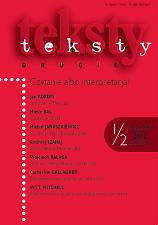Spojrzenie Meduzy
Medusa's gaze
Author(s): Jan KordysSubject(s): Literary Texts
Published by: Instytut Badań Literackich Polskiej Akademii Nauk
Keywords: Medusa; gaze; Mythgology; Vladimir Toporov; Fine Arts; Primo Levi
Summary/Abstract: The point of departure for the article is an analysis of the phenomenon of gaze exchange where both are realised: our desire to be with others (intimacy), and the need to remain different from them. The reflection in the other's eyes (co)creates our identity, the very feeling of existence is connected with the face and the gaze exchange. Greek anthropology gave us an exceptional material related to the visual and cognitive categories (“to look,” “to be seen,” “recognise oneself in others”), shaping social structure and forms of relations. An individual exists in the gaze of the members of the community who are equal with and similar to him/her. Mythology brings a different image: gaze exchange is a field of tensions, conflicts and catastrophes. Both the (self)reflexive relation in the myth of Narcissus as well as the killing gaze of Gorgon-Medusa, the figure of chaos, regress to the formless, seem lethal. The works of Vyacheslav Ivanovich Ivanov, Vladimir Nikolayevich Toporov point to the Middle-Eastern origins of the symbolic of the Gorgon-Medusa, while the analysis by Jean-Pierre Vernant and Françoise Frontisi-Ducroux locate the image of the monster in a vast iconographic and mythological field of former Greece. The last parts of the article are devoted to the function of the “Medusa's gaze ” as a periphrasis describing the Muselman in The Drowned and the Saved by Primo Levi.
Journal: Teksty Drugie
- Issue Year: 2012
- Issue No: 1-2
- Page Range: 13-38
- Page Count: 26
- Language: Polish

